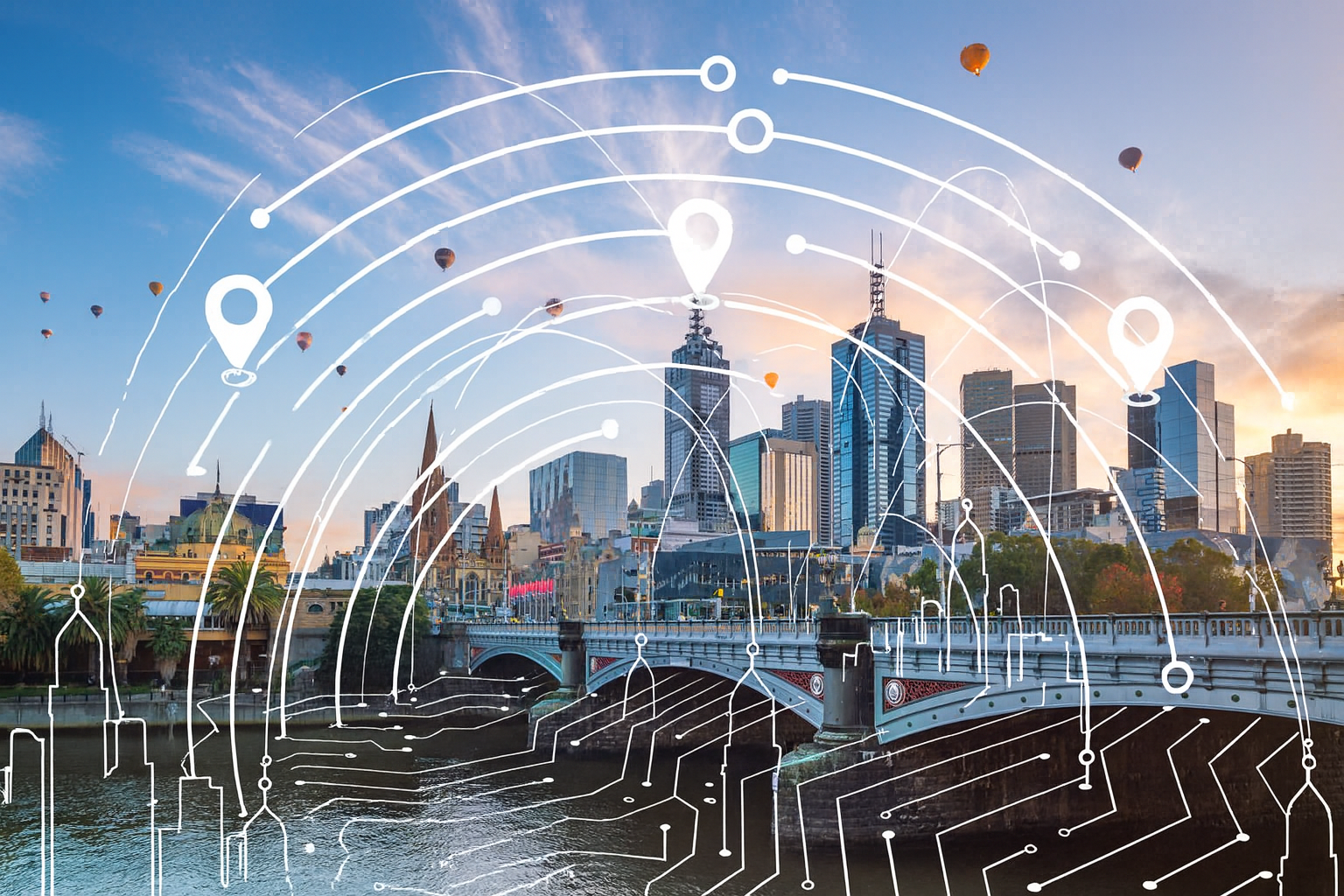Artificial Intelligence’s Sustainability Challenge
Science Victoria Edition

By Gordon Noble
Institute for Sustainable Futures, University of Technology Sydney (UTS)
As the uptake of artificial intelligence (AI) grows, how can we manage the energy and water risks that come with machine learning models?
One of the least understood aspects of the technology revolution we have witnessed over the last twenty years is how energy and water intensive it has been.
There is significant uncertainty on the energy use of machine learning models, such as ChatGPT, due to factors including a lack of reporting.1 As technology develops, with new applications emerging, understanding and managing the impacts on energy and water demand will be critical.
CO2 emissions from software-related activities currently account for 4-5% of global emissions.2 By 2040, it is estimated that this number may climb to 14%.3 This is because the backbone of software use is ‘data storage or processing services’, that are delivered by the data storage or processing sector.4
Data storage principles and infrastructure

Everything digital is stored somewhere, even if it is only for a short amount of time. Every single website, everything in the ‘cloud’, has associated storage – most of it on hard drives in data storage centres around the world. While these centres vary in size, large data storage centres are essentially thousands (or even tens of thousands) of interconnected hard drives, operating 24/7. These servers consume an enormous amount of energy, and generate an enormous amount of heat – like a scaled-up version of your own computer.
Companies have different options for storing their data, and their choice(s) will reflect their needs. They might have their own server room on-site, or their own data storage centre, requiring them to own and manage the infrastructure. Alternatively, they might use a third-party data storage centre provider, like the Australian Government’s use of Macquarie Data Centres, or cloud-based data centres, such as Amazon Web Services (AWS). The largest cloud-based storage providers like AWS have what are referred to as “hyperscale” data centres (i.e., massive facilities), storing data for millions of customers.
The need for electricity and water
According to the International Energy Agency, data centres and data transmission networks accounted for 0.9% of energy-related greenhouse gas emissions in 2021.5 In the one year, global data centre electricity use was 220-320 TWh, or around 0.9-1.3% of the global final electricity demand.5
One of the major reasons why data centres use so much energy is to keep servers cool. Like any large facility, they commonly use cooling towers, which require water to operate. As use of AI grows exponentially, we are already seeing an increased demand for water from big technology companies. Google’s onsite water consumption increased by 20% between 2021 and 2022, with Microsoft increasing water consumption by 34% increase over the same period.6 AI consumes 1.8-12L of water for each kWh of energy usage across Microsoft’s global data centres.6 In the United States, it is estimated that 1 MWh of energy consumption by a data centre requires 7,100L of water.7

Data centre demands on the local area
There is an increase for data centres here in Australia, and the challenge is to understand how the growth of AI will impact the demand for energy and water resources. Data centres especially impact the areas in which they are located, often on the urban fringe of major cities. Concerns have been raised that, as the size and number of data centres increases, they will introduce new environmental stresses in additional locations.7
As new data centres are built, it is important to consider how the demand for energy varies with weather conditions. As Australia faces the prospect of heat stress across Australia, with the potential that warming of 2°C may lead to 50°C days in Sydney and Melbourne, household need for energy for cooling competes with data centre demand.8,9
In Ireland, the cool and wet climate has been an advantage for operating data centres, and Ireland is now home to 25% of Europe’s data centres, including newly constructed hyperscale data centres.10 However, the large number of data centres, with projections for future growth, is now leading to instability in Ireland’s energy grid. According to Ireland’s Central Statistics Office, electricity consumption by data centres increased by 32% in 2021 alone.11 Over a six-year period to December 2021, electricity consumption by data centres increased by 265%. According to EirGrid, Ireland’s energy grid manager, 28% of all electricity demand in Ireland is expected to come from data centres and other new large energy users by 2031.12
Mitigating the resource needs
Singapore is a hub for data centres in South-East Asia, accounting for more than 60% of the region’s data centre market. In a country where the temperature rarely drops below 20°C, up to 40% of total energy consumption of a typical data centre relates to cooling.13 To address the associated energy costs, the Singapore Government launched the world’s first standard for optimising energy efficiency for data centres in tropical climates, which will result in data centres gradually increasing their running temperatures from 22°C to 26°C and above.14
Singapore’s actions demonstrate that it is possible for data centres to operate at higher temperatures. During periods of extreme heat, demand on the energy grid needs to be properly managed, especially by large energy users, to ensure that the grid remains stable for everyone. For data centres, this will mean needing to respond dynamically to heat events by allowing servers to operate at higher temperatures for short periods of time.
In Australia, which has been an importer of technology rather than an innovator,15 a lack of understanding on how the growth of AI can impact energy and water consumption has meant that there has been a lack of action. Reviewing data storage facilities and their impact on the local environment is a key step to understanding their national impacts, and deciding appropriate action. This is assisted by particular measures and ratings of facilities.
One measure of operational sustainability is the National Australian Built Environment Ratings System (NABERS) ratings system for buildings Ratings are calculated after consideration of energy efficiency, water usage, waste management, and environmental impact.16 However, even using systems like this have drawbacks. A 2021 report from CSIRO found that the value of the NABERS data centre database was limited due to the small number of facilities reviewed, the voluntary nature of obtaining a review (skewing the set to newer, more efficient facilities), and the lack of insight specifically about the efficiency of the computing equipment.17,18
We therefore need to address the uncertainty surrounding current energy usage before we can accurately project future energy usage by data centres, and subsequently develop data-driven policies.
Understanding the (carbon) cost of addressing business needs
The UTS Institute of Sustainable Futures recently undertook an investigation into the state of sustainability and IT, and revealed an alarming trend.19 While many Australian companies dedicate time and money to reduce emissions, and sustainability managers understand the importance of data and IT to achieving sustainability goals, few have a clear view of what their company’s increasing reliance on digital technologies is doing to create carbon emissions. This is not a trivial issue. It has significant implications for regulators, policy makers, company boards, and the rest of us, who increasingly compete with IT companies and data centres for electricity.
Of the more than 100 sustainability managers surveyed, 81% thought that demand for data management would increase, yet only 22% indicated that their organisation pays sufficient attention to data centre energy consumption. Only 5% of respondents felt that the quality of sustainability-related data received from data centre service operators was detailed enough.19
This likely reflects several realities. There may be a communication challenge between IT teams and sustainability managers; and importantly, while data centre operators, including hyperscale data centre providers, are making strides in reducing emissions themselves, and reporting it, there is no standardised or regulatory requirement for IT based emissions reporting in Australia.
Given the urgency of this issue, and the certainty that demand will only increase, there is a need to develop a framework for IT and data centre “Sustainability Roadmaps”, which would provide harmonised reporting of IT and data centre-based emissions and water consumption. This would help accelerate the availability of climate-related sustainability data aligned with international climate-related financial reporting standards, and improve social and governance management practices, including reporting of data protection standards and sovereignty of data arrangements.
–
This article draws upon the report, IT and Data Centre Sustainability in Australia, co-authored by Gordon Noble from the UTS Institute for Sustainable Futures (ISF) in partnership with Pure Storage.
The report is available at uts.edu.au/isf/news/australian-businesses-unaware-emissions-crisis-it-and-data-centres
References:
- Heikkilä, M. (2022, November 14). We’re getting a better idea of AI’s true carbon footprint. MIT Technology Review. technologyreview.com/2022/11/14/1063192/were-getting-a-better-idea-of-ais-true-carbon-footprint/
2. Software emissions are equivalent to air, rail, and shipping combined | State of Green Software. (2022). State of Green Software; Green Software Foundation. stateof.greensoftware.foundation/insights/software-emissions-are-equivalent-to-air-rail-shipping-combined/ - Podder, S., et al. (2020, September 18). How Green Is Your Software? Harvard Business Review. hbr.org/2020/09/how-green-is-your-software
- Security of Critical Infrastructure Act 2018, (2022). legislation.gov.au/Details/C2022C00160
- Kamiya, G. (2022). Data Centres and Data Transmission Networks – Analysis. IEA. iea.org/reports/data-centres-and-data-transmission-networks
6. Hodgkinson, I. R., & Jackson, T. (2023, August 7). Three steps for businesses to make AI data and compute more sustainable. OECD.AI Policy Observatory. oecd.ai/en/wonk/three-steps-sustainable-compute-data - Siddik, M. A. B., et al. (2021). The environmental footprint of data centers in the United States. Environmental Research Letters, 16(6), 064017. doi.org/10.1088/1748-9326/abfba1
- Projecting future heat stress in Australia using climate models. (2023, December 15). The ARC Centre of Excellence for Climate Extremes. climateextremes.org.au/projecting-future-heat-stress-in-australia-using-climate-models-2/
- Australian Academy of Science. (2021). The Risks to Australia of a 3°C Warmer World. Australian Academy of Science. science.org.au/files/userfiles/support/reports-and-plans/2021/risks-australia-three-deg-warmer-world-report.pdf
- Reddan, F. (2019, February 28). Dublin is now Europe’s largest data hosting cluster. The Irish Times. irishtimes.com/business/technology/dublin-is-now-europe-s-largest-data-hosting-cluster-1.3808500
- Key Findings - Data Centres Metered Electricity Consumption 2021. (2022, March 5). Central Statistics Office. cso.ie/en/releasesandpublications/ep/p-dcmec/datacentresmeteredelectricityconsumption2021/keyfindings/
12. Ireland Capacity Outlook 2022-2031. (2022, October). EirGrid. eirgridgroup.com/site-files/library/EirGrid/EirGrid_SONI_Ireland_Capacity_Outlook_2022-2031.pdf - Green Data Centre Technology Roadmap. (2015). National Climate Change Secretariat - Singapore. nccs.gov.sg/files/docs/default-source/default-document-library/green-data-centre-technology-roadmap.pdf
- IMDA introduces sustainability standard for data centres operating in tropical climates. (2023, June 8). IMDA. imda.gov.sg/content-and-news/press-releases-and-speeches/press-releases/2023/imda-introduces-sustainability-standard-for-data-centres-operating-in-tropical-climates
15. Nguyen, K., & Hambur, J. (2023). Adoption of General-purpose Technologies (GPT) in Australia: The Role of Skills | Bulletin – September 2023. bulletin. rba.gov.au/publications/bulletin/2023/sep/adoption-of-general-purpose-technologies-gpt-in-australia-the-role-of-skills.html - Data Centres. (2020, January). NABERS. nabers.gov.au/ratings/spaces-we-rate/data-centres
17. NABERS Annual Report 2021-2022 Program Statistics: Data Centres - Energy. (2022). NABERS. nabers.info/annual-report/2021-2022/data-centres-energy/ - Lindsay, S., Cavanagh, K., & Lovasz, T. (2021). Data Centres and the Australian Energy Sector. CSIRO. near.csiro.au/public/assets/669e70f6-9c53-4eb2-9728-37a13f76edb1/D_11_2.pdf
- Australian businesses unaware of emissions crisis from IT and data centres. (2023, July 18). UTS Institute for Sustainable Futures. uts.edu.au/isf/news/australian-businesses-unaware-emissions-crisis-it-and-data-centres
Discover how you can join the society
Join The Royal Society of Victoria. From expert panels to unique events, we're your go-to for scientific engagement. Let's create something amazing.
















